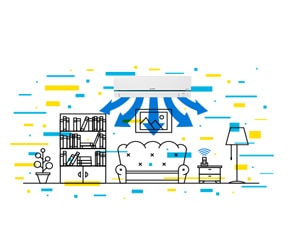VRF, or Variable Refrigerant Flow, is an innovative technology. This groundbreaking, compelling, adjustable warming and cooling framework offers great returns on investment. More often than not, different people have varying needs when it comes to air conditioning, as different zones in a building may require different temperature levels. The cooling and heating requirements of different spaces may even change throughout the day. That is where VRF HVAC systems come into play. VRF systems utilise innovative technology to simultaneously change and maintain completely different temperatures in different zones as per the requirements throughout the property, heating or cooling different zones accordingly. VRF HVAC systems find numerous applications across industries and are especially useful in large commercial buildings where temperature control varies significantly throughout the floor. There are numerous advantages of a VRF system that you should consider the next time you plan to buy a new air conditioning system:
Customised Heating and Cooling
The primary benefit of VRF HVAC systems is that they can cool one zone to one set temperature and another to a different set temperature, while simultaneously heating yet another zone, and so on. VRF systems capture the heat that is recovered during the cooling process and redistribute the excess heat to areas that need to be heated. The different output vents can be controlled by the inhabitants according to their preferences.
Consistent Comfort
The compressor unit of the VRF system accurately identifies the requirements of each zone and sends the exact amount of cooling or heating that is required to each air handling unit. This precise flow of air conditioning helps in increasing productivity and provides consistent comfort to the occupants of the building.
Quiet Operation
In VRF systems, the noisy condensing unit is typically placed outside the building, which enhances the quiet operations of the HVAC system as compared to conventional systems. Additionally, the air handlers in VRF systems are smaller and quieter than those that involve a large central unit with bulky ductwork.
Energy Efficient
One of the best advantages of VRF systems is that it promotes energy efficiency. Conventional HVAC systems run on a single temperature throughout the day. A VRF system is designed to operate at varying temperatures depending on the requirements of each space in the building. This results in the VRF system running at a lower capacity which uses less energy.
Flexibility for Small Places
VRF systems are highly preferred in commercial buildings due to their compact size and flexibility. There is no need to dedicate a large space for a maintenance room or service shafts, as VRF systems can be easily installed in confined spaces. VRF systems contribute significantly to space-saving since ductwork and mechanical rooms are not required.
If compact commercial or residential spaces and reducing the carbon footprint for increased efficiency is a concern, exploring the advantages of VRF systems is a must. A well-researched VRF system for your office or residential space will provide superior comfort, energy savings, and design adaptability as compared to traditional AC systems.





Comments